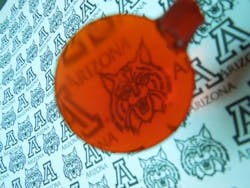Sulfur left over from refining fossil fuels can be transformed into cheap, lightweight plastic lenses for infrared devices such as thermal-imaging cameras and night-vision goggles, a team led by the University of Arizona (UA; Tucson, AZ) has found.1
"We have for the first time a polymer material that can be used for quality thermal imaging -- and that's a big deal," says Jeffrey Pyun, whose lab at the UA developed the plastic. "The industry has wanted this for decades."
Other members of the team include researchers from Seoul National University in (Seoul, South Korea) and the University of Delaware (Newark, DE).
Easily molded
In contrast to the materials currently used in IR technology, the new plastic is inexpensive, lightweight, and can be easily molded into a variety of shapes, says Pyun. The researchers have filed an international patent for their new chemical process and its application for lenses. Several companies have expressed interest in the technology, he says.
Robert Norwood and his colleagues in the UA College of Optical Sciences tested the optical properties of the new lens materials and found they are transparent to mid-range infrared and result in lenses with high optical focusing power.
The team's discovery could provide a new use for the sulfur left over when oil and natural gas are refined into cleaner-burning fuels. Although there are some industrial uses for sulfur, the amount generated from refining fossil fuels far outstrips the current need for the element.
The new plastic is transparent to wavelengths of light in the mid-IR range of 3 to 5 μm (along with the 1.5 μm region of the near-IR), has a refractive index between 1.865 to 1.745, and is formed into lenses via silicone molds.
The chemists dubbed their process "inverse vulcanization" because it requires mostly sulfur with a small amount of an additive (vulcanization is the chemical process that makes rubber more durable by adding a small amount of sulfur to rubber). The team's next step is comparing properties of the new plastic with existing plastics and exploring other practical applications such as optical fibers.
REFERENCE:
1. Jared J. Griebel et al., Advanced Materials (2014); doi: 10.1002/adma.201305607

John Wallace | Senior Technical Editor (1998-2022)
John Wallace was with Laser Focus World for nearly 25 years, retiring in late June 2022. He obtained a bachelor's degree in mechanical engineering and physics at Rutgers University and a master's in optical engineering at the University of Rochester. Before becoming an editor, John worked as an engineer at RCA, Exxon, Eastman Kodak, and GCA Corporation.
